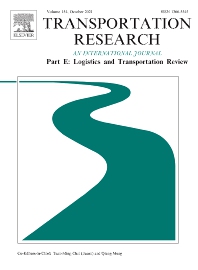
Promoting Electric Vehicle Adoption: Who Should Invest in Charging Infrastructure?
Publication Year: 2021
Author(s): Kumar RR, Chakraborty A, Mandal P
Abstract:
Electric mobility has emerged as a key initiative for policymakers and governments to mitigate the transportation sector's carbon footprint. However, the adoption of electric vehicles (EVs) is slow, primarily due to the scarcity of adequate charging facilities. The intriguing factor in developing charging infrastructure is related to which entity should invest in developing the same. In this paper, the authors study a vehicle supply chain and formulated four different modes of developing charging infrastructures for EVs when: (a) EV manufacturer invests in setting up the charging infrastructure with a government subsidy to EV consumers, namely the Model M, (b) EV manufacturer invests in setting up the charging infrastructure, namely the Model R (c) Government invests in setting up charging infrastructure and also provides a subsidy to EV consumers, namely the Model MG, and (d) Government invests in setting up the charging infrastructure; namely the Model G. The findings show that the Model MG and M are equally effective for generating the maximum EV demand and market share, thereby require maximum effort for developing the charging infrastructure. Further, the results show that the EV manufacturer always benefits from government initiatives, whereas the GV manufacturer doesn't benefit from these initiatives. Under the Model MG, M, and G, the government support in the form of subsidy or building the charging infrastructure allows the EV manufacturer to charge a higher market price while increasing EV adoption, resulting in higher profits. Further, social welfare is also maximum in these two cases, which is counterintuitive because government support is more in the Model MG as compared to the Model M. Hence, under a limited budget constraint, the government can provide direct subsidy to EV consumers and let EV manufacturer invests in charging infrastructure to maximize social welfare. Further, the Model MG and M have a lower overall environmental impact when GV's environmental impact is higher than a threshold. The results suggest that governments need to encourage manufacturers to improve technologies, to reduce the environmental impact. Additionally, the authors provide multifaceted policy recommendations for the government and manufacturer strategic choices under different scenarios.
Source of Publication: Transportation Research Part E: Logistics and Transportation Review
Vol/Issue: 149, 102295: 1-22p.
DOI No.: 10.1016/j.tre.2021.102295
Country: India
Publisher/Organisation: Elsevier Ltd
Rights: Elsevier Ltd
URL:
https://www.sciencedirect.com/science/article/abs/pii/S1366554521000697#!
Theme: Charging Infrastructure | Subtheme: Public charging station
Related Documents
Reports
Charging India’s Four-Wheeler Transport
Published Year: 2020
Abstract:
India has two categories of electric cars, based on their range and battery capacity. The curr... Read More
Standards
Charging Infrastructure for EVs - Revised Guidelines and Standards
Published Year: 2019
Abstract:
The guidelines & standards for charging infrastructure for the electric vehicle were issue... Read More
Standards
Charging Infrastructure for Electric Vehicles-Guidelines and Standards 2018
Published Year: 2018
Abstract:
Government of India have taken multiple initiatives to promote manufacturing and adoption of e... Read More



